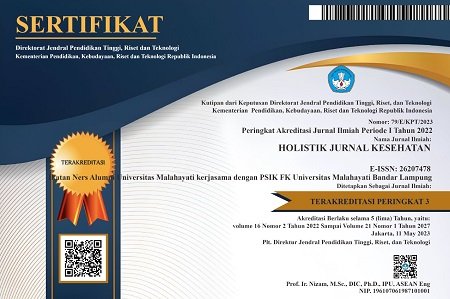Tingkat aktivitas fisik pada anak dengan gangguan spektrum autisme : A narrative review
Abstract
Physical activity of children with autism spectrum disorders: A narrative review
Background: Autism spectrum disorder is a developmental disorder characterized by impaired communication, social interaction, and repetitive behavior. ASD children experience limitations in performing daily activities. Physical activity can reduce the symptoms and skills deficiencies that are present in ASD.
Purpose: The literature review was to conduct a study of the level of physical activity with ASD children.
Method: The narrative review, articles were collected through the CINAHL, Pubmed, Researchgate, and Garuda Ristek Dikti databases. The keywords used are children with autism OR autism spectrum disorder AND physical activity. The criteria for the articles collected are full text articles, in English and Indonesian, published in 2011-2020 and the type of study used is non-experimental quantitative articles.
Results: The literature study got 8 articles which found that low level of physical activity with ASD children. ASD children engage in low physical activity, are physically inactive and spend little time doing physical activity.
Conclusion: Physical activity in ASD girls was significantly lower than in boys. This literature study can be used as information for health workers in providing information on the importance of physical activity in children with ASD and the need for further research on programs and interventions for physical activity in children with ASD to get enough daily physical activity to reduce the disorders that exist in children with ASD.
Keywords: Children; Autism; Physical activity
Pendahuluan: Gangguan spektrum autisme merupakan gangguan perkembangan yang ditandai dengan gangguan komunikasi, interaksi sosial, dan perilaku repetitif. Anak-anak GSA mengalami keterbatasan dalam melakukan aktivitas sehari-hari. Aktivitas fisik dapat menurunkan gejala dan kekurangan keterampilan yang ada pada GSA.
Tujuan: Studi literatur ini memiliki tujuan untuk melakukan kajian tingkat aktivitas fisik dengan anak GSA. Metode: Metode yang digunakan dalam studi literatur ini adalah narrative review. Artikel dikumpulkan melalui database CINAHL, Pubmed, dan Researchgate. Kata kunci yang digunakan yaitu children with autism OR autism spectrum disorder AND physical activity. Kriteria artikel yang dikumpulkan yaitu artikel fulltext, berbahasa Inggris dan Indonesia, dipublikasikan tahun 2011-2020 dan jenis studi yang digunakan artikel kuantitatif non eksperimental.
Hasil: Hasil studi literatur mendapatkan sebanyak 8 artikel yang menemukan bahwa rendahnya tingkat aktivitas fisik dengan anak GSA. Anak-anak GSA terlibat dalam aktivitas fisik yang rendah, tidak aktif secara fisik dan sedikit waktu yang dihabiskan dalam melakukan aktivitas fisik.
Simpulan: Aktivitas fisik pada anak perempuan GSA secara signifikan lebih rendah daripada anak laki-laki. Studi literatur ini dapat dijadikan sebagai informasi tenaga kesehatan dalam memberikan informasi pentingnya aktivitas fisik pada anak dengan GSA serta diperlukannya penelitian lebih lanjut mengenai program dan intervensi aktivitas fisik pada anak-anak dengan GSA untuk mendapatkan aktivitas fisik harian yang cukup untuk mengurangi gangguan yang ada pada anak-anak GSA.
Keywords
References
American Psychiatric Association. (2018). What Is Autism Spectrum Disorder? Retrieved September 9, 2020, from https://www.psychiatry.org/patients-families/autism/what-is-autism-spectrum-disorder
Bandini, L. G., Gleason, J., Curtin, C., Lividini, K., A., & S. E., Cermak, S. A., Maslin, M., Must, A. (2014). Comparison of physical activity between children with autism spectrum disorders and typically developing children. National Institutes of Health, 17(1), 44–54. https://doi.org/10.1177/1362361312437416.Comparison
Centers for Disease and Control Prevention. (2020). Data & Statistics on Autism Spectrum Disorder. Retrieved November 2, 2020, from https://www.cdc.gov/ncbddd/autism/data.html
Gehricke, J. G., Chan, J., Farmer, J. G., Fenning, R. M., Steinberg-Epstein, R., Misra, M., Parker, R.A.,& Neumeyer, A. M. (2020). Physical activity rates in children and adolescents with autism spectrum disorder compared to the general population. Research in Autism Spectrum Disorders, 70, 1–13. https://doi.org/10.1016/j.rasd.2019.101490.Physical
Healy, S., Haegele, J. A., Grenier, M., & Garcia, J. M. (2016). Physical Activity , Screen-Time Behavior , and Obesity Among 13-Year Olds in Ireland with and without Autism Spectrum Disorder. Journal of Autism and Developmental Disorders. https://doi.org/10.1007/s10803-016-2920
Hwang, Y. I. (Jane), Srasuebkul, P., Foley, K. R., Arnold, S., & Trollor, J. N. (2019). Mortality and cause of death of Australians on the autism spectrum. Autism Research, 12(5), 806–815. https://doi.org/10.1002/aur.2086
Janssen, I., & Leblanc, A. G. (2010). Systematic Review of the Health Benefi ts of Physical Activity and Fitness in School-Aged Children and Youth. International Journal of Behavioral Nutrition and Physical Activit, 7(40). https://doi.org/10.1201/b18227-18
Katzmarzyk, P. T., Denstel, K. D., Beals, K., Bolling, C., Wright, C., Crouter, S. E., ... & Stanish, H. I. (2016). Results from Kenya’s 2016 report card on physical activity for children and youth. Journal of Physical Activity and Health, 13(11), S195–S200. https://doi.org/10.1123/jpah.2016-0359
Kementerian Pemberdayaan Perempuan Dan Perlindungan Anak. (2016). Retrieved August 14, 2020, from https://www.kemenpppa.go.id/index.php/page/read/24/1011/pembangunanmanusia-berbasis-gender-tahun-2012
Lau, F., & Kuziemsky, C. (2016). Handbook of eHealth Evaluation: An Evidence-based Approach. In Handbook of eHealth Evaluation: An Evidence-based Approach. Retrieved from https://www.ncbi.nlm.nih.gov/books/NBK481590/pdf/Bookshelf_NBK481590.pdf
MacDonald, M., Esposito, P., & Ulrich, D. (2011). The physical activity patterns of children with autism. BMC Research Notes, 4(1), 1–5. https://doi.org/10.1111/j.1469-8749.2008.03242.x
Mccoy, S. M., & Morgan, K. (2019). Obesity , physical activity , and sedentary behaviors in adolescents with autism spectrum disorder compared with typically developing peers. Autism, (2016), 1–3. https://doi.org/10.1177/1362361319861579
Memari, A. H., Ghaheri, B., Ziaee, V., Kordi, R., Hafizi, S., & Moshayedi, P. (2012). Physical activity in children and adolescents with autism assessed by triaxial accelerometry. Pediatric Obesity, (7), 150–158. https://doi.org/10.1111/j.2047-6310.2012.00101.x
Memari, A. H., Panahi, N., Ranjbar, E., Moshayedi, P., Shafiei, M., Kordi, R., & Ziaee, V. (2015). Children with Autism Spectrum Disorder and Patterns of Participation in Daily Physical and Play Activities. Neurology Research International, 2015. https://doi.org/10.1155/2015/531906
Pan, C. Y., Tsai, C. L., Chu, C. H., Sung, M. C., Ma, W. Y., & Huang, C. Y. (2016). Objectively Measured Physical Activity and Health-Related Physical Fitness in Secondary School-Aged Male Students With Autism Spectrum Disorders. Physical Therapy, 96(4), 511–520. https://doi.org/10.1111/j.1467-9639.1993.tb00256.x
Srinivasan, S. M., Pescatello, L. S., & Bhat, A. N. (2014). Current perspectives on physical activity and exercise recommendations for children and adolescents with autism spectrum disorders. Physical Therapy, 94(6), 875–889. https://doi.org/10.2522/ptj.20130157
Stanish, H., Curtin, C., Must, A., Phillips, S., Maslin, M., &, & Bandini, L. (2016). Enjoyment, barriers, and beliefs about physical activity in adolescents with and without autism spectrum disorder. Adapted Physical Activity Quarterly, 32(4), 302–317. https://doi.org/10.1123/APAQ.2015-0038.
Suryani, A., & Sudarsono, N. C. (2017). Exercise For Children With Autism Spectrum Disorders. The 1st Yogyakarta International Seminar on Health, Physical Education, and Sports Science, (2), 256–260.
Tyler, K., MacDonald, M., & Menear, K. (2014). Physical Activity and Physical Fitness of School-Aged Children and Youth with Autism Spectrum Disorders. Autism Research and Treatment, 2014, 1–6. https://doi.org/10.1155/2014/31216
World Health Organization. (2019). Autism spectrum disorders. Retrieved September 13, 2020, from https://www.who.int/news-room/fact-sheets/detail/autism-spectrum-disorders
Zhao, M., & Chen, S. (2018). The Effects of Structured Physical Activity Program on Social Interaction and Communication for Children with Autism. BioMed Research International, 13. https://doi.org/10.1155/2018/1825046
Zuckerman, K. E., Hill, A. P., Guion, K., Voltolina, L., & Fombonne, E. (2014). Overweight and Obesity : Prevalence and Correlates in a Large Clinical Sample of Children with Autism Spectrum Disorder. Journal of Autism and Developmental Disorders. https://doi.org/10.1007/s10803-014-2050-9
DOI: https://doi.org/10.33024/hjk.v15i4.5233
Refbacks
- There are currently no refbacks.
Copyright (c) 2021 Holistik Jurnal Kesehatan

This work is licensed under a Creative Commons Attribution-NonCommercial 4.0 International License.














